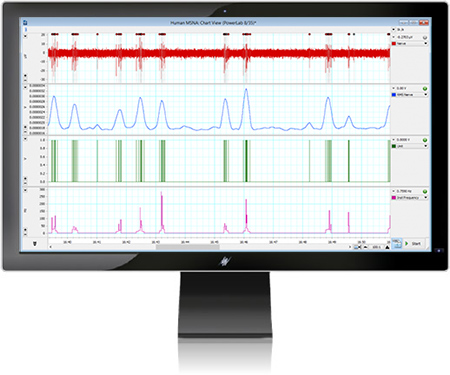View this on-demand webinar to learn about microneurography techniques and research trends for the study of nerve stimuli and associated responses in human subjects.
Professor Vaughan Macefield, one of the world’s leading neurophysiologists in the field of microneurography, speaks about the current trends in this field, and specifically shares methodology, tips and best practices that he uses in his lab to answer complex questions about physiological processes and associated stimuli.
Related: Demonstration of Microneurography analysis in LabChart »
Webinar Overview:
-
Introduction
-
History of the microneurography technique
-
Microneurogrpahy research solutions:
- The Neuro Amp EX - a low-noise and high-gain isolated differential amplifier suitable for all recording environments requiring a wide bandpass (100 Hz to 5 kHz) and a high signal-to-noise ratio.
- Attaching the Tungsten Microelectrode to the subject
Find out more about our microneurography research solutions »
-
Examples of common microneurography research applications and approaches:
- Typical Muscle sympathetic nerve activity (MSNA) recording
- Human Golgi Tendon Organ recording
- Fast-adapting type I cutaneous afferent recording
- Slowly-adapting type II cutaneous afferent recording
- Multi-unit recording of spontaneous bursts of MSNA
- Individual postganglionic sympathetic axon recording
- Concurrent recordings of sympathetic nerve activity and fMRI
-
Q & A Session
About the speaker:
Professor Vaughan Macefield, PhD, DSc
Senior Principal Research Fellow at the Baker Heart and Diabetes Institute

'Professor Macefield specializes in recording from single nerve fibres via microelectrodes inserted into the peripheral nerves of awake human subjects (microneurography), and is best known for developing the methodology for recording the firing properties of single, type-identified, sympathetic neurones supplying muscle and skin and, most recently, for developing the methodology for recording muscle sympathetic nerve activity (MSNA) at the same time as performing functional magnetic resonance imaging (fMRI) of the brain.'

LabChart - All you microneurography analysis in one place
The Spike Histogram Module for LabChart is specifically designed for the discrimination and analysis of extracellular neural spike data in real-time. Discriminated spikes can be viewed in specialized histogram windows including amplitude histogram, rate meter, peristimulus histogram, autocorrelogram and more. Find out more »